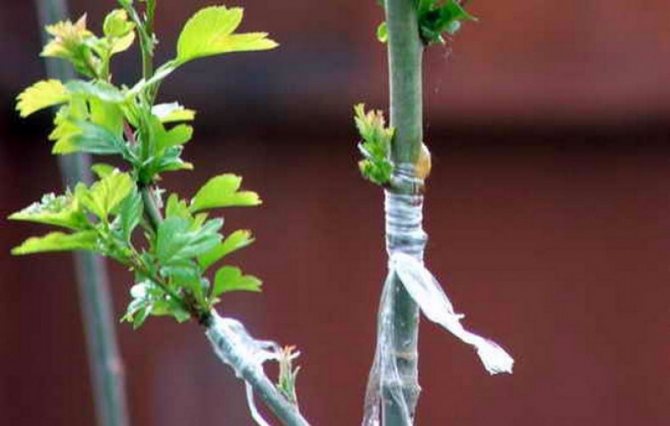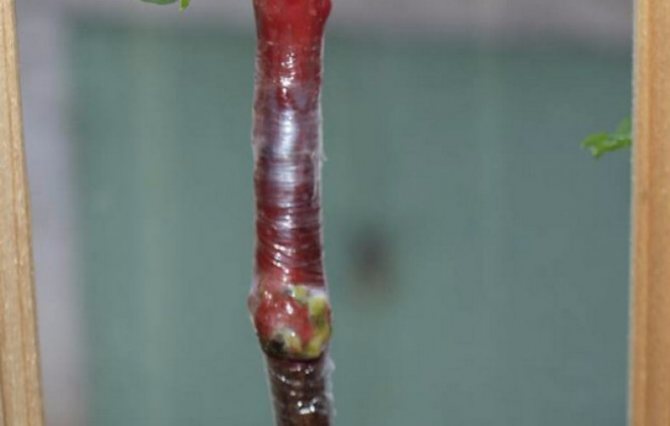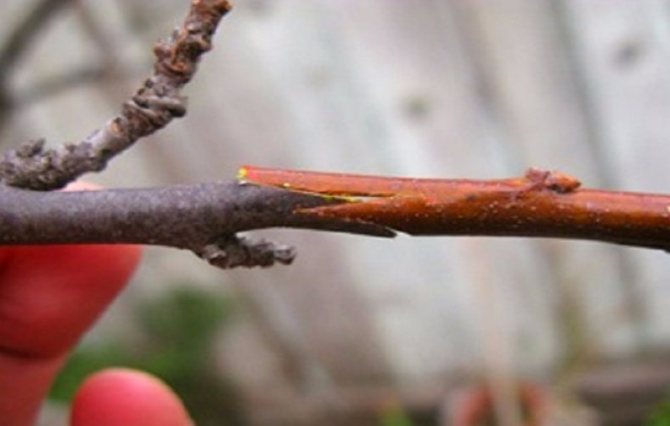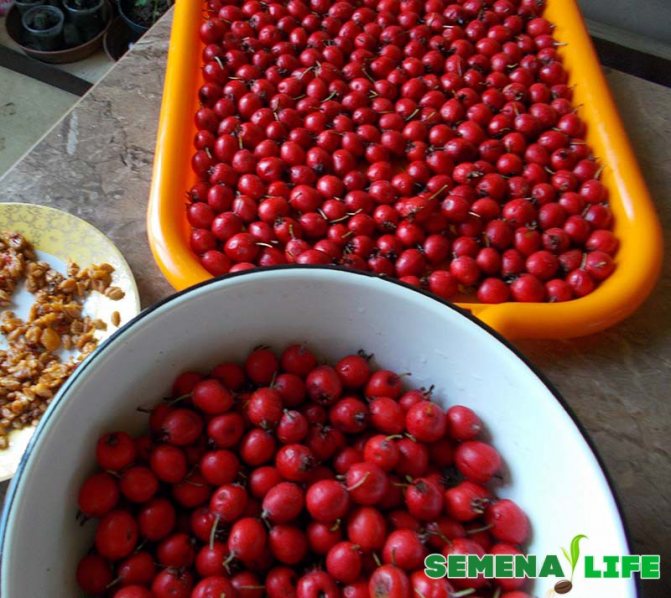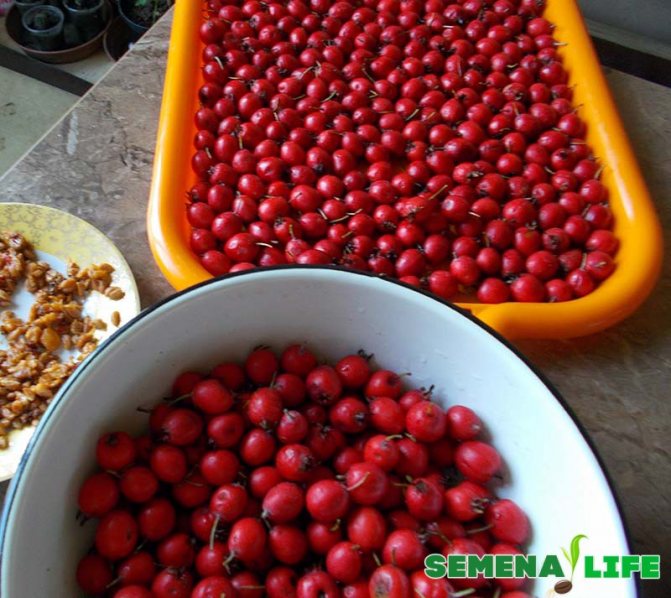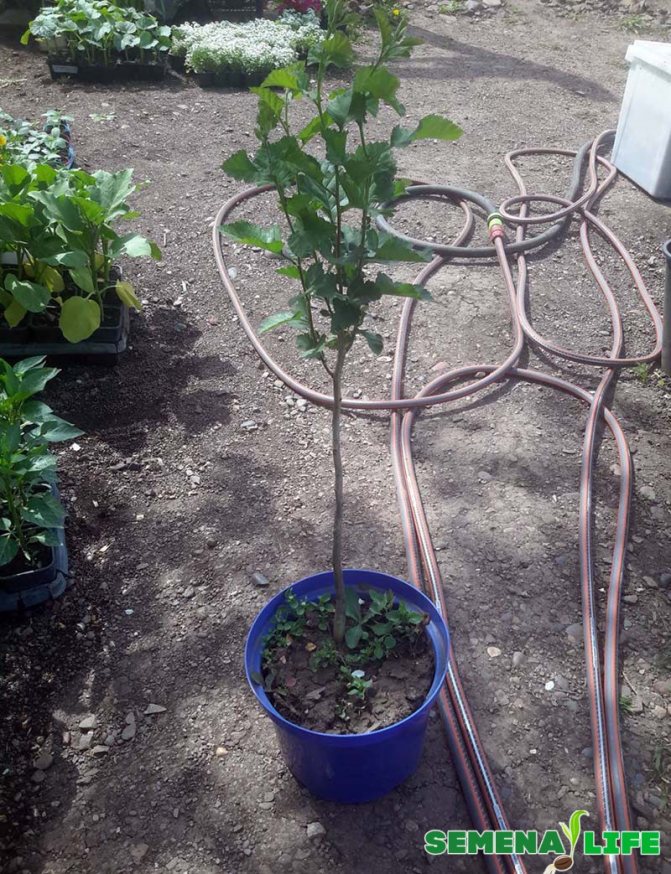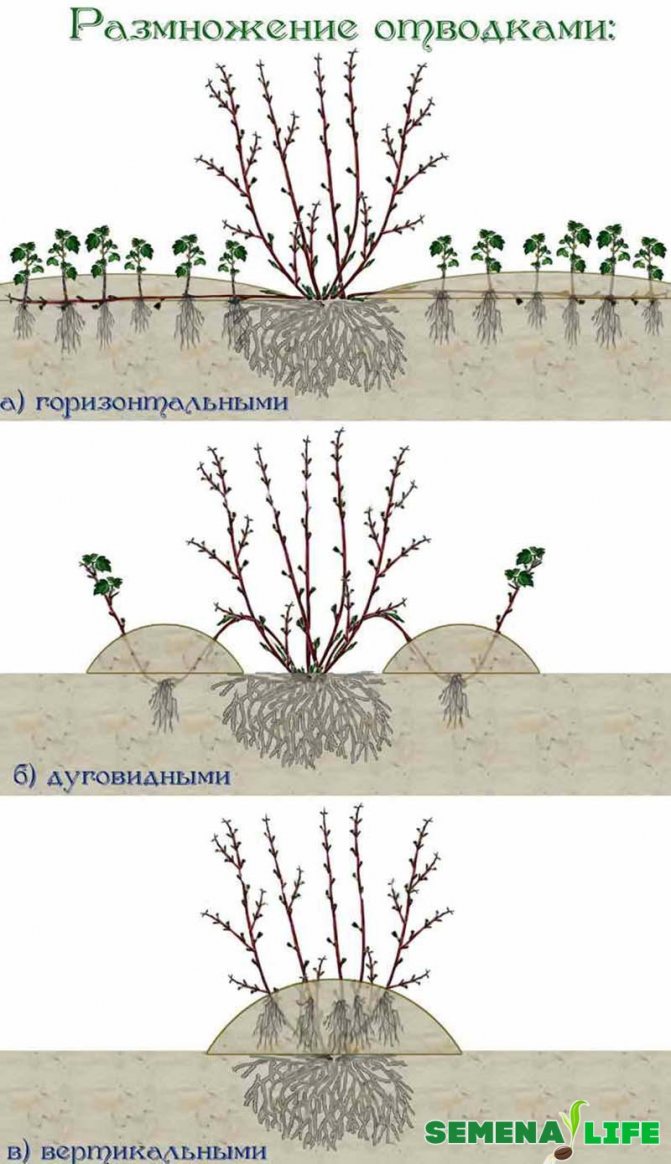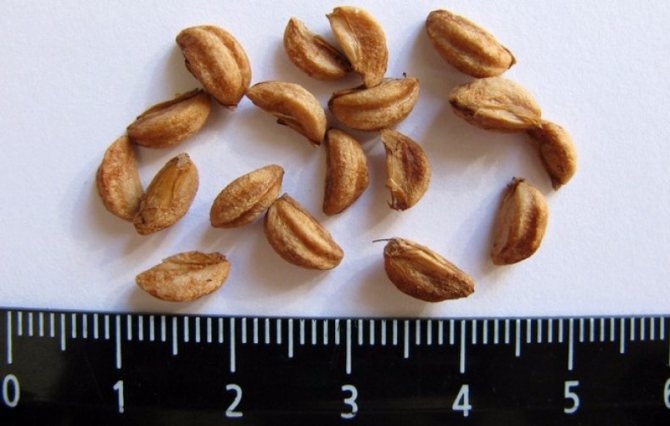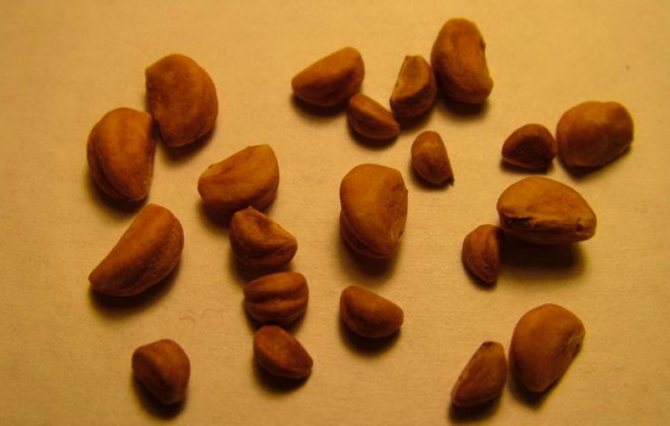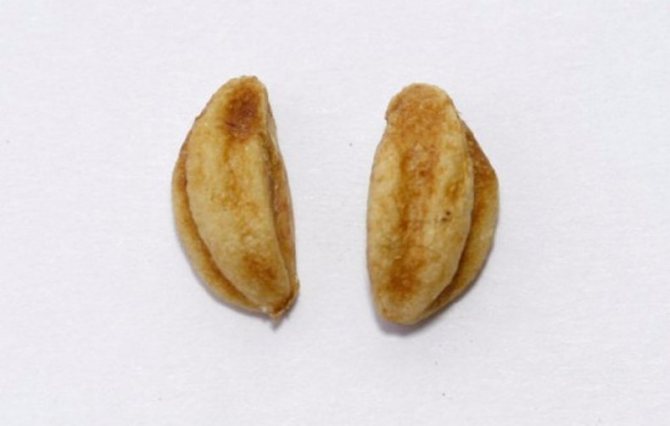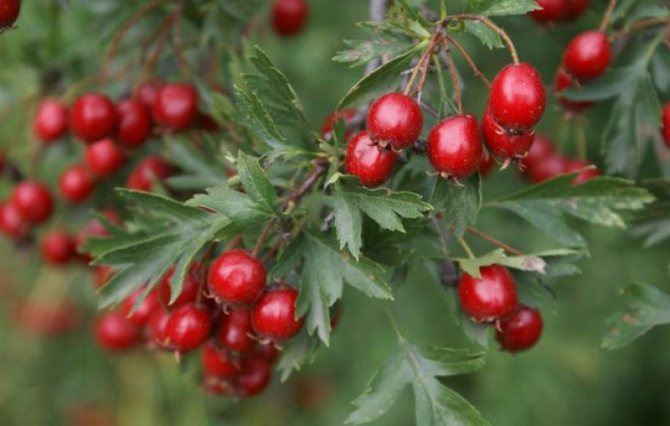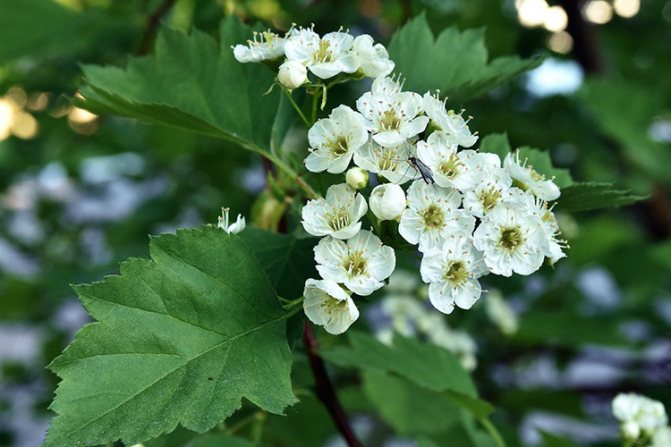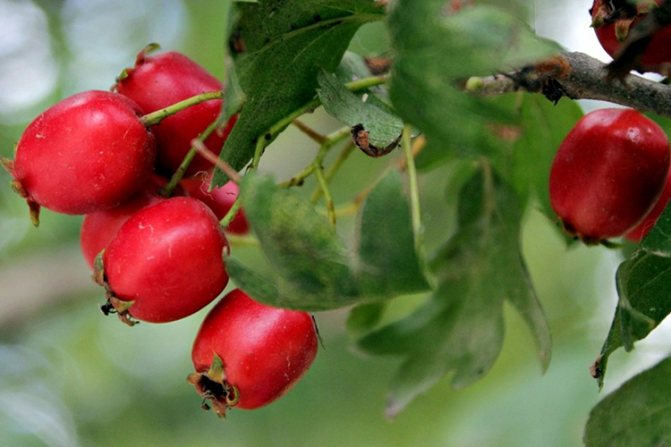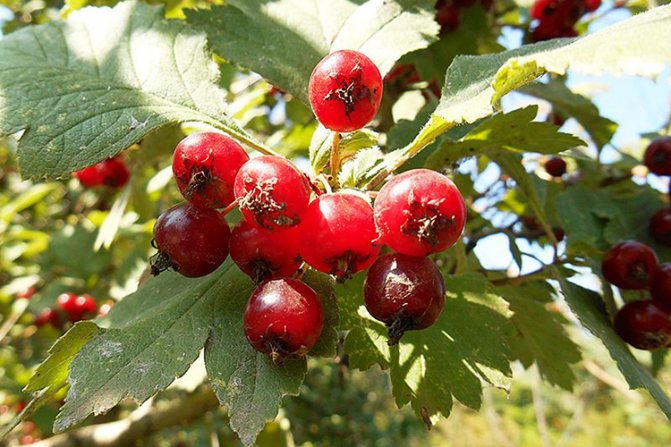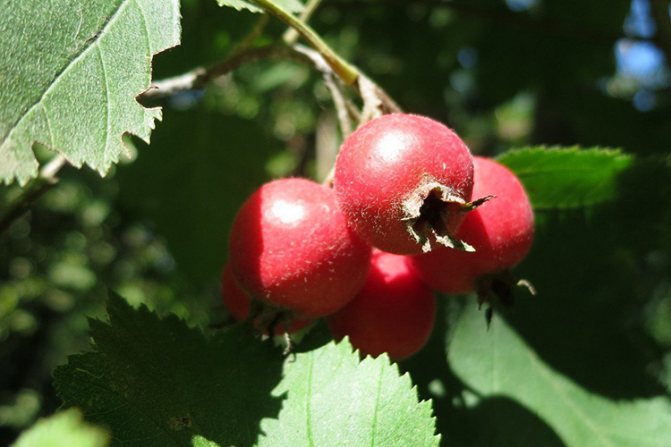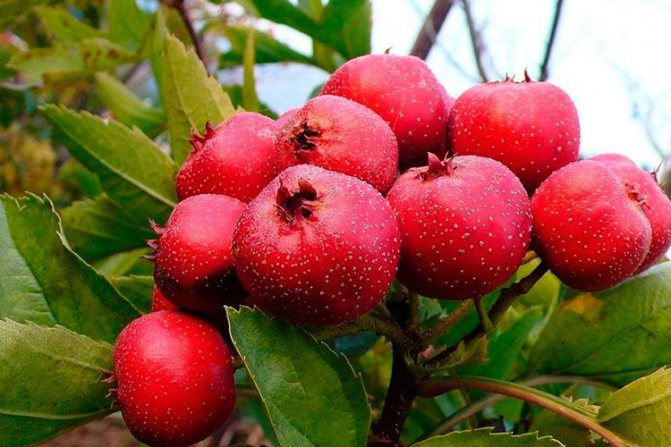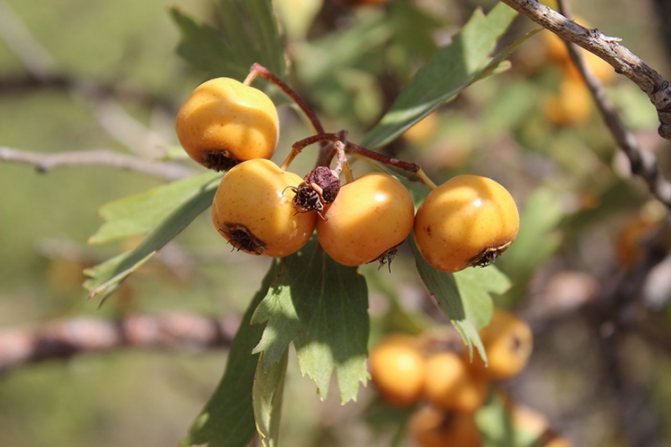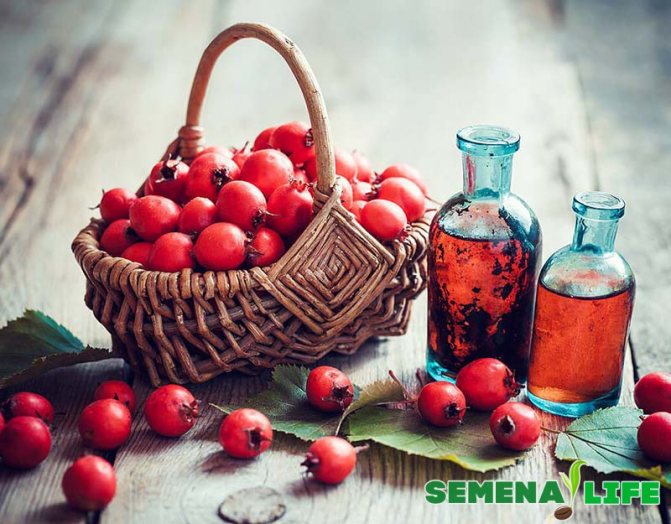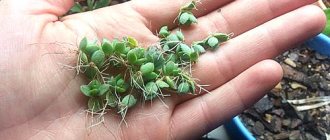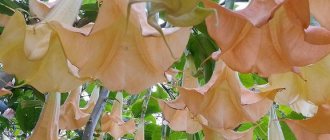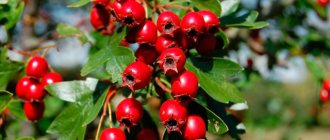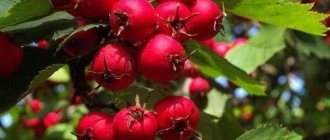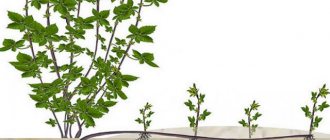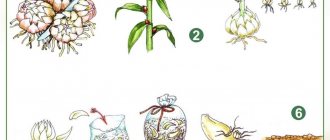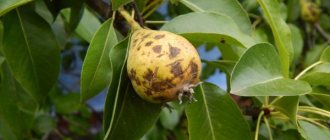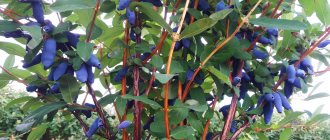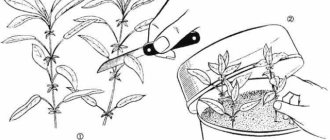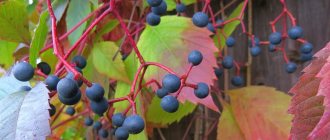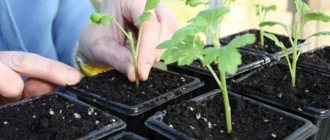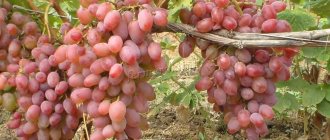How to propagate hawthorn
When choosing a method for propagating a shrub, you need to focus on what is available - seeds or a bush, from the shoots of which you can cut cuttings, dig in layers or separate root shoots. However, for greater efficiency, you can try several options at once.
Seeds
The work of propagating hawthorn seeds by seeds takes a lot of time and effort, so the method is not suitable for novice gardeners. Most often they resort to it if it is necessary to get new plants of a rare variety. Those who want to choose this particular method will need to prepare seeds, substrate and containers for growing.
For reproduction of large-fruited hawthorn, it is necessary to select healthy, large and not quite ripe berries in the fall. Cut them and select the seeds, and sort out of them only the largest ones, of the correct shape. Plant seeds germinate hard without treatment, so they need stratification:
- First you need to soak them in warm water along with the rest of the pulp.
- After a day, drain the water and remove the pulp. Then soak the seeds for another day in 1% sodium nitrate solution.
- Then wrap them in cloth, put them in the refrigerator or put them in the cellar, where they can be stored all winter.
- You can not wrap it in a cloth, but mix it with wet sand, put the mass in a container and put it in the cold.
The capacity for germinating hawthorns needs a wide and deep one. The substrate for this plant is prepared from leafy earth, peat, humus and coarse sand. A little chalk is added to it. Before pouring into pots, the substrate is spilled with a solution of potassium permanganate and dried. A drainage layer 15 cm high is laid at the bottom of the containers. Due to their poor germination, hawthorn seeds can be sown thickly and shallowly. Sprinkle on top with a thin layer of substrate and cover the pots with foil or put in a small greenhouse. After the shoots appear, the film can be removed.
Before transplanting into the ground, the plants need to be watered under the root with warm water so that the ground constantly remains moist, but does not dry out and is not wet. After each such watering, it is necessary to loosen the soil around the plants. For a year it is necessary to fertilize the hawthorn 2 times with organic matter. It grows slowly, during the season it grows by 15-20 cm. When it grows to a height of 30 cm, that is, after about 2 years, it can be transplanted to the site.
Sometimes hawthorns are sown directly into open ground. This will require last year's seeds. The place should be sunny, not necessarily damp. Before sowing in the fall, dig up the ground, fertilize with humus or compost (not fresh, but well rotted). Hawthorn seeds are sown in shallow grooves to a depth of only 1-1.5 cm, slightly sprinkled with ordinary earth on top, and watered well. For the winter, the garden bed is covered with a leaf or pine, cedar, spruce dry needles. When sowing hawthorn seeds in open ground, they can germinate late - after a year or a half.
Cuttings
They are cut from green young shoots, in the spring - before budding on them, in the fall - after the leaves crumble. For propagation by cuttings in the spring, choose one-year or two-year flexible shoots, the thickness of which is not more than 1 cm. It is advisable to choose those that are on the southern side of the bush.The required length of the cuttings is 10-15 cm, the lower cut is made obliquely. It is better to cut hawthorn cuttings from the middle share of the shoots, the tops and base are not suitable, since the cuttings from them take root very poorly.
The lower leaves are cut off from the blanks, the halves are removed from the upper ones. Hawthorn cuttings are planted in a greenhouse in a sandy-peat substrate, maintaining a distance of 20 cm in a row and up to 40 cm in a row spacing. During the day before planting, the slices are kept in a solution of Kornevin or any other root former. The humidity in the greenhouse for rooting must be at least 80%, for which it is covered with foil or glass. To create a high humidity inside the greenhouse, the inside of the glass is sheathed with a light cloth. It will absorb nighttime moisture, which will evaporate during the day, creating a fog.
When the first leaves appear on the cuttings, they begin to open the film every day, first for 10-15 minutes, then the time is gradually increased. Water the rooting hawthorn so as to keep the soil moist. Fertilized with organic matter. Cuttings take root for a long time, the process can take 1.5-2 years. This is considered a disadvantage of the hawthorn propagation method by cuttings. In any case, only after a year can the plant be planted in its place in the garden. The distance between the bushes should be at least 2 m.
Hawthorn at home can be propagated not only by green cuttings, but also by root cuttings. The time for harvesting the material is autumn, after leaf fall. Cuttings are cut from young roots, their length should also be about 10-15 cm. In winter, they are stored in a cellar in wet sand or in a perforated film. In early spring, when the soil warms up, but not yet dry, the cuttings are planted in the garden. They are almost completely immersed in the ground, only a 1 cm long part is left at the top.In order for hawthorn cuttings to root well and give green growth, they must grow at high humidity. To do this, a small film cover is installed above them. It will be possible to remove it when young green shoots appear from the ground.
Root offspring
This method propagates bush hawthorn. At the very end of summer or early autumn, one-year root shoots are separated from the mother bush with a shovel, but they are not completely dug out. In this form, the plants overwinter, in the spring, before the start of sap flow, they are dug up and transferred to the garden, where they will grow.
Layers
This method is also only suitable for bush forms. They begin to carry out work in the spring, when the spring frosts end, last year's shoots are selected from the bottom of the bush, bend them to the ground and laid in dug trenches. From above they are covered with earth and lightly tamped with it. The tops of the shoots should be at the top, only the middle part should be covered. For reliability, hawthorn branches are pinned to the ground with metal pins or brackets. Layers are watered and covered with mulch so that the soil does not dry out quickly. If the summer is hot, the buried layers will need to be watered so that they can take root well. New hawthorn plants are dug up in the fall, after the foliage has fallen, or in the spring, before the leaves bloom on them.
When is the best time to land
Many people think that in the fall it remains only to harvest, remove the fallen leaves, and you can rest until spring. In fact, the best time to replant the plant is in the fall. At this time, the prices are more favorable and the assortment is larger. Many seedlings are sold with multiple fruits so that the buyer can see what he is buying. In the fall, minimal maintenance is required, as long-term warm weather and regular rains create favorable conditions for rooting.
Photo:
Despite the fact that the plant is in a dormant period, the root system continues to grow until the soil temperature drops below +4 degrees Celsius.The main thing is not to miss the time of planting the seedling, so that the young roots have time to form even before the onset of frost. Such roots will grow faster in the spring than those transplanted in the spring. Also, the advantages of hawthorn include the fact that the plant will harden during the winter. Such seedlings will be stronger than their counterparts planted in the spring.
Photo:
When choosing a location, decide on the purpose of the hawthorn. To create a hedge, seedlings must be planted around the perimeter of the site.
"If you want to get a good harvest, choose a well-lit place in the northern part, the plant is not afraid of direct sunlight."
Hawthorn grafting
The method is considered one of the best for breeding this type of shrub. In home gardens, hawthorns are planted in 3 ways: in the cleft, in the butt, and by copulation. Vaccination is done in the spring, before bud break, or in the fall, when the leaves fall. Cuttings can be cut just before grafting or in the fall. In the second case, they need to be stored until spring in a cold place - in the cellar (in damp sand or in film) or in the lower compartment of the refrigerator.
Cuttings are cut from 2 annual shoots about 1 cm thick. They must be completely healthy, without traces of diseases and not damaged by pests, located on the south side of the bush. The length of the cuttings should be such as to accommodate 3-4 buds.
The sequence of work, depending on the vaccination option:
- Into the cleft. First, at the required height, a branch is cut off on the bush to be grafted onto. She will be the stock. Then a horizontal deep incision (5 cm) is made on it with a sharp knife. The scion-cutting is carefully inserted into it. Its lower cut should be cut obliquely from 2 sides, the upper one should be straight. The vaccination site is wrapped with elastic tape in several layers. It should lie tightly so as not to allow air and moisture to pass through, but you do not need to wrap it tightly so as not to pinch the fabric. The upper cut of the scion is smeared with garden var. The tape and garden varnish prevent the cutting from drying out and getting pathogens on open tissues. After about a month, when the scion has taken root, which can be understood by the green leaves that appear, the tape is weakened, and by the middle of summer it is completely removed.
- In the butt. This method differs from the previous one in that the scion is not inserted into an incision in the middle of the rootstock, but into an incision made on its lateral surface. Accordingly, the lower part of the scion is cut obliquely only from 1 side. It is important that both cuts - on the branch and on the handle, are the same length. The butt method is suitable for grafting a bush if the stock is thicker than the scion.
- Copulation. It is considered an effective and therefore a popular vaccination option. As many gardeners note, it guarantees almost 100% survival rate, shoots quickly enter fruiting. In order for the copulation results to be excellent, the scion and rootstock grow together quickly, it is important to ensure that the thickness of the branches is the same. This is necessary so that the layers of tissue, in particular the cambium, are correctly combined with each other. On the handle and rootstock, oblique diagonal cuts are made of the same length, but in different directions, then the branches are connected together and wrapped with tape.
Hawthorn can be grafted onto another plant of the same species, for example, on an old bush for rejuvenation, or on a mountain ash. In the case of mountain ash, you can get not a shrub, but a small compact tree. Branches grafted in accordance with all the rules begin to bear fruit the next season.
On the hawthorn itself, you can graft some pear varieties (Talgar beauty, Carpathian, Goverla, Bere Kievskaya and Zolotovorotskaya). They are said to develop even better and bear fruit more quickly than when grafted onto regular pears.
Expert opinion Mila Rozhkova Flower expert Ask an expert Gardeners who want to propagate hawthorn can choose the method that suits them best. This can be growing from seed, rooting of cuttings, overgrowth or grafting of cuttings. As you can see, the reproduction of this plant, which is not yet widespread in Russian gardens, is almost no different from the reproduction of other types of shrubs.
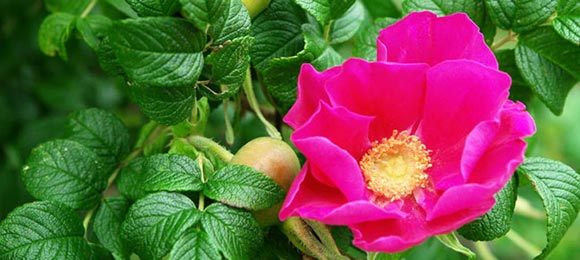
Rosehip is a genus of shrubs of the Rosaceae family, a close relative of the garden rose.
It is used as an ornamental plant to decorate the garden with beautiful pink flowers. Can serve as a hedge with thorns. It is also appreciated for its medicinal fruit containing a large amount of vitamins.
What is hawthorn, its useful qualities, features and characteristics
In nature, hawthorn has many species, but only 50 varieties are cultivated in gardens and vegetable gardens, which multiply without much difficulty using cuttings, seeds obtained from the fruit of the plant.
Since ancient times, this plant has been used by people as an ornamental plant, decorating the landscapes of parks, gardens and adjoining territories. The hawthorn during flowering is a particularly beautiful sight, its appearance is impeccable. The bush is completely covered with white or pinkish inflorescences, against the background of bright green or burgundy foliage, they look irresistible, and when the plant is covered with red berries, it becomes simply fabulous.
Read also: How to build a fireplace in landscape design in your country house
Traditional medicine has also long ago adopted the healing properties of the plant and uses it for various types of ailments. The fruit contains a large amount of trace elements such as potassium, calcium, zinc, iron, copper and others. And vitamins are represented by such groups: A, E, K, B, C. Tinctures, decoctions and teas based on hawthorn help with such ailments: diseases of the cardiovascular system, pathology of the digestive tract, diseases of the nervous system and blood vessels.
For the preparation of medicinal drugs, flowers and fruits of the plant are used, however, you should be aware of the contraindications and precautions for these drugs. For some groups of people, the use of these folk remedies is strictly prohibited, these include children under 12 years old, pregnant women and nursing mothers. Overuse of a powerful drug such as hawthorn tincture can lead to dizziness and hallucinations.
How to grow rose hips from seeds
1. Collecting seeds
- Seeds are harvested in August from unripe, slightly reddened fruits, when their shell has not yet hardened;
- They are cleaned, washed and allowed to dry;
- Mix with coarse wet sand 1: 1.
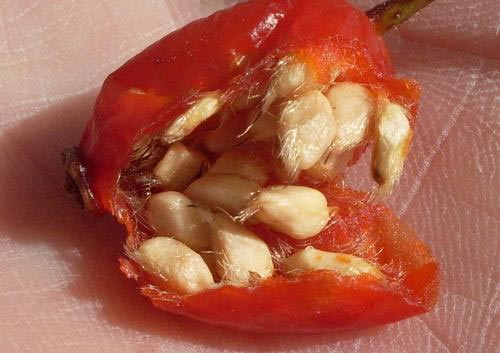

2. Stratification
note
Seed stratification is the creation of conditions close to natural for their better germination.
To do this, the seeds are placed in a refrigerator or basement, along with sand (for at least two months), stirring regularly.
3. Sowing
Produced in autumn, as seeds stratify better during winter. Rosehip seedlings may appear next spring or in the second year.
- Seeds are sown in open ground to a depth of 2 cm;
- Watering is carried out;
- The land is mulched with sawdust and humus;
- In early spring, the crops are covered with a film to accelerate germination, while regularly ventilating;
- After the appearance of two leaves, the crops dive;
- At stable positive temperatures, the film is removed.
If the seeds are planned to be sown in spring, then in winter they should be stored in wet sand in containers at a temperature of 2-3 degrees, for example, in the basement, stirring them periodically.
Hawthorn seed sowing method
Collect unripe fruits, soak them in water for 1-2 days, then rub through a sieve and rinse.Place the resulting seeds in a potassium nitrate solution (1%) for a day, and then sow them into the ground before winter. Seeds remain viable for 1-2 years.
By the way, my seeds, sown before winter without treatment, remained viable for 3 years. Hawthorn has a lot of empty seeds, so sowing needs to be done thicker.
Hawthorn seedlings are beautiful, like angels, and look like apple seedlings. Leaves of the same shape as in adult plants appear later. The stem is claret pink. In the first year, the seedlings grow very slowly, only 10 centimeters. Then the growth accelerates, and after 7-8 years it slows down again.
In my mini-nursery, I removed weeds, sometimes watered - that's all the care. After 3-5 years, I transplanted the seedlings to a permanent place, and gave most of them to neighbors and iconic ones.
How to choose the right cuttings?
Most importantly, you need to choose the right shoot, from which cuttings will be cut in the future. Most budding growers make the big mistake of choosing shoots that grow upward, but make poor cuttings. They simply cannot form a root system. In order to propagate the hawthorn by the grafting method, you need to collect shoots from the side branches that do not grow very actively. Also, when cutting cuttings, one feature must be taken into account: if you take one long shoot and cut it into several parts, then the cuttings that were closer to the part of the base take root. In order for the selected shoots to become good cuttings, there are a number of rules. It is necessary to choose shoots:
- Not frozen.
- Which do not have any damage to the bark.
- Shoots that are ripe, that is, annual. Not desirable, but you can take biennials as well.
- Shoots for grafting should be taken from the middle layer of the hawthorn. It is advisable to take those that grow from the southern part of the tree crown.
- When cutting cuttings, it is necessary to take into account the factor that the length of each should be from 10 to 15 centimeters, and the thickness from 7 to 8 millimeters.
Seat selection
A characteristic feature of this unpretentious plant is the ability to adapt to any conditions. The tree will grow both in the sun and in the shade. There are many shade-tolerant hybrids. You can recognize them by the color of the leaf plates: the darker they are, the easier the culture tolerates the absence of ultraviolet radiation.
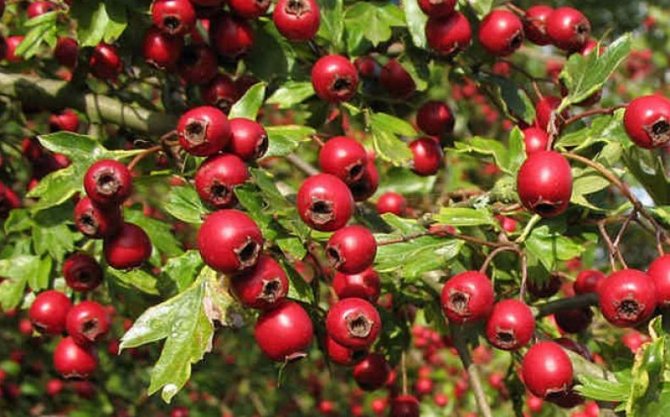

If you plan to decorate your garden with delicate flowers, and even collect the harvest, then the choice must be made in favor of a sunny site. Strong wood of young and mature seedlings does not get burned even after prolonged exposure to direct sunlight.
They have a particularly beneficial effect on variegated varieties, which lose their color in the shade and turn green. Far from the sun, any kind of hawthorn will show off only foliage, and you will not see flowers and fruits.
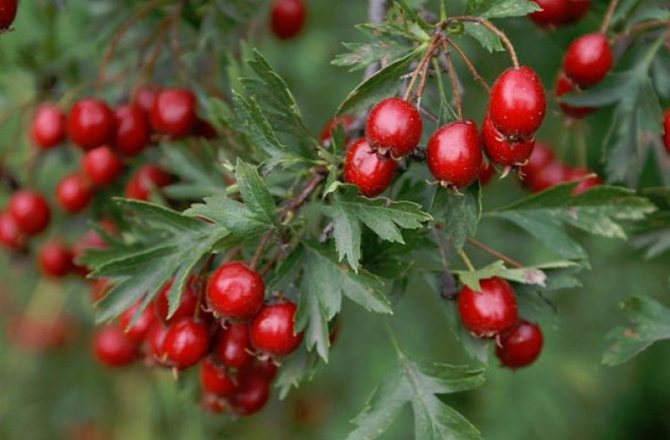

In addition to lighting, it is important to take into account the peculiarities of the soil composition and its acid reaction. The plant prefers humus-rich, neutral or slightly alkaline substrates. Although it can adapt even to heavy loams and poor sandstones, in this case, retardation in development is inevitable.
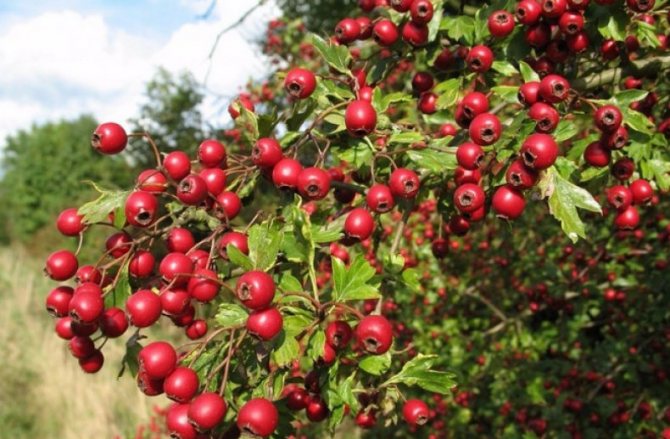

Experts say that an area with an excess of calcium is good for planting hawthorn. If there is none, then you will have to make your own adjustments. An acidic environment should be avoided, where water stagnates and cold air collects during rains and thaws.
Reproduction by layering
To obtain hawthorn seedlings with the help of layering, shoots from 1 to 2 years old are selected. They must be placed in a previously dug groove in the ground. The shoot is settled into a groove so that the top of the plant remains on the surface. The laid shoot is fixed in the ground with a bracket and lightly sprinkled with light, nutritious soil. It is also necessary to overtighten the base of the layering with a wire.Gardeners recommend this method of reproduction in the spring, as a last resort, at the beginning of summer, so it is possible to get a ready-made seedling in the fall.
In the process of reproduction by layering, the plant in the place of the digging must not only be watered, but also fertilized. A solution of ammonium nitrate is very suitable for fertilization. You need to fertilize the plant once a month. Also, as young shoots germinate, you need to gradually add soil to strengthen the root system of young plants. The best option would be to mulch them with straw, hay or peat. By the fall, shoots and hawthorns will take root. After that, they must be carefully cut off from the layering and transplanted as an independent plant.
Hawthorn: planting and care in the open field
Common hawthorn is a large-fruited tree from the genus hawthorn, of the Pink family. The average age of the tree is about 300 years. It looks like a large shrub at the beginning of growth and as a tree 3-8 m in height at an older age. The trunk and branches of a light gray shade with spines up to 3 cm, with the exception of pinnacle hawthorn. This variety is the only one that does not have thorns on the branches. The leaves are thin, dark green above, light green below, at the ends of the branches are jagged, and the rest are three-lobed.
Flowers up to 1.5 cm in diameter, collected in inflorescences of 6-12 pieces. Hawthorn blooms in late spring - early summer, and bears fruit by early autumn. Elliptical fruits, up to 1 cm in diameter, can be blood-red, yellow and whitish, the pulp is juicy.
Hawthorn grows both in North America and throughout Eurasia. In Russia, it will also bloom and bear fruit perfectly both in the Moscow region and in Primorye.
The most common varieties of hawthorn for summer cottages:
In order not to worry about careful care in the future, you need to choose the right growth conditions for the hawthorn before planting. The main factors of planting a tree, like everyone else, are the choice of soil, the degree of lighting and humidity of the area. It will depend on this whether the plant will hurt, whether it is necessary to additionally water and feed it, how it will bloom and bear fruit.
Method of grafting "constriction"
With this method, an already well-formed shoot that has matured is selected. 3 lower leaves are removed from it and just below the bud, the shoot is well pulled with soft wire. Then you need to take some moss and rinse it well with boiling water. Then add a little garden soil and a couple of drops of a root stimulant to it - this can be heteroauxin. The whole mixture is slightly moistened with water from a spray bottle. Then you need to take a cellophane tape measuring 10 by 20 centimeters, put moss with a peat mixture on it and bandage the shoot with cellophane at the waist. It should look like a cast is being put on the arm. As a result, it should turn out that on the shoot in the area of the constriction, a cocoon of peat mixture should be obtained. In the place where the constriction was made, the process of disrupting the juice of the movement will occur, which passes from the leaves to the roots. The plant, in turn, will begin to fight against the constriction, as a result of which a small influx of tissue will form in this place. As a result, after 2 months, roots will form in the place where there will be a constriction, and after 4 months the entire cocoon of cellophane tape will be pierced with roots. As soon as this happens, you can carefully cut off the shoot from the trunk, just below the waist, remove the cellophane and move the stalk with roots for growing.
Harvesting and storage
Most phytotherapists equally practice treatment with inflorescences and hawthorn berries, so they recommend stocking up on raw materials on time.
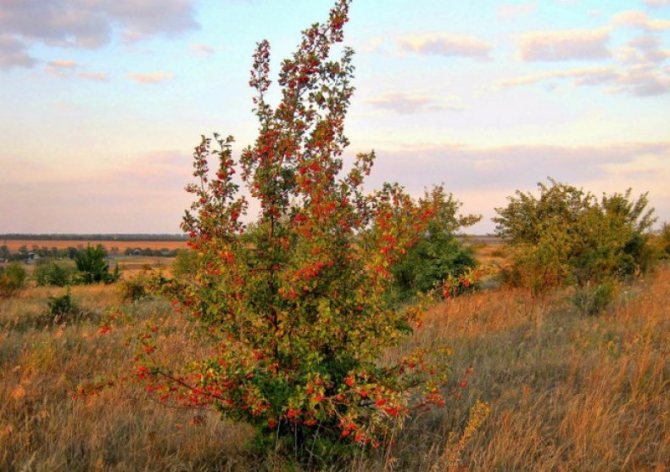

The preparation of peduncles is relevant at the beginning of flowering.Then the flower brushes are completely cut off with scissors, which are distinguished by a sharp unpleasant aroma and a bitter aftertaste. Herbalists advise to collect only fully opened flowers, avoiding buds. The fact is that during the drying process, they darken, which negatively affects the chemical composition of the raw material.
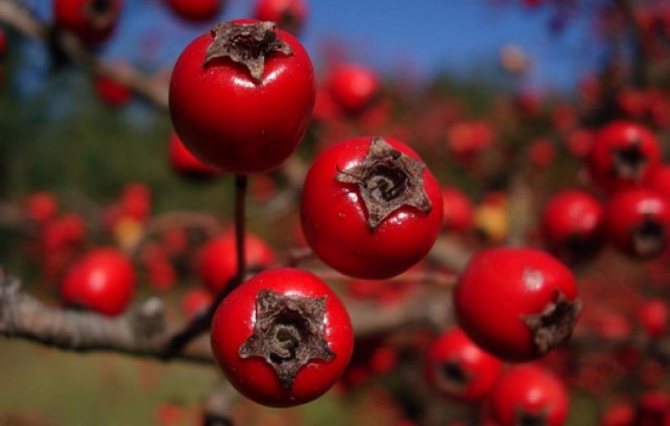

The berries are torn off in the last weeks of September when they turn completely red and soft. In some species, ripe fruits immediately begin to crumble (for example, Arnold's variety). Therefore, monitor the condition of the crop and try to remove it from the bush before the onset of cold weather. In frozen berries, the amount of vitamin C decreases, which affects their healing properties.
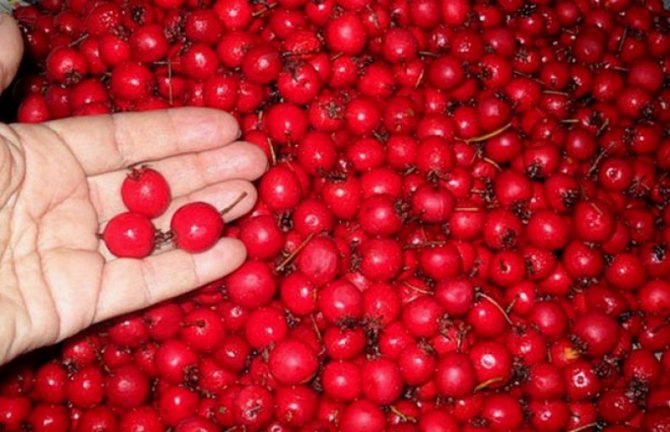

Plan the procurement of raw materials in dry weather. And if it rains or dew falls, wait until the plant is dry. After harvesting, the flower clusters and fruits are dried somewhere in the attic, away from direct sunlight. For these purposes, you can use electrical devices, setting the temperature to 40 ° C. With the latter option, drying should be carried out for 2 hours.
It is recommended to store the workpiece in tightly closed glass containers. Make sure the lids close well, as the hawthorn absorbs moisture very well. The shelf life of the inflorescences is 1 year, and the berries can be saved up to 2 years.
As you can see, the main secret of growing a beautiful and fertile plant is to love and care for it. And in the case of hawthorn, an elementary minimum is enough for a lush hedge or a single shrub to bloom in your garden, which will thank you with healing fruits in the fall.
Large-fruited hawthorn should be grown in every garden. Effective as a single plant. Planting in a row along the border of the lot will create an impenetrable hedge. It is beautiful during flowering and pleasing to the eye in autumn, when covered with red fruits, and the leaves change color to autumn tones. The fruits are edible and have medicinal properties. He does not need special care, he is winter-hardy and drought-resistant.
Cuttings
Propagation of hawthorn by cuttings is a possible, but not the easiest way, with a high probability of an unsuccessful result.
Cuttings of this shrub take root for a very long time and are extremely reluctant, so when choosing this method, be prepared for the fact that painstaking work for several years in a row may ultimately be in vain. Cuttings should be started in early spring, before sap flow has begun. If rooting will be done in a greenhouse, cuttings can be cut in the fall after the shrub has shed its leaves.
As cuttings, you need to choose green shoots with a thickness of a little less than 1 cm, without signs of woodiness, freezing or damage. It is best to choose one-year branches, in extreme cases - two-year ones.
Important! Branches from the top of the bush are not suitable for grafting. You should choose lateral shoots growing on the south side, and not the most developed ones. It is best to cut off such a branch almost at the base and remove the excess part from above, leaving a length of 10-15 cm, since the apical hawthorn cuttings practically do not take root.
The lower branches of the bush are also poorly suited for grafting.
Cut the cuttings diagonally under the bud. We use only a very sharp tool!
We place freshly cut cuttings in a rooting machine for an hour (you must first purchase it in a specialized store) and only after that we plant it.
As a soil mixture, you can use peat or sand (or perlite) in equal parts, or you can use ordinary soil, but the earth must be loose and well fertilized. It is also recommended to add lime fertilizer to the soil - defect or ordinary chalk.
Learn also about the reproduction of such shrubs as honeysuckle, honeysuckle, magnolia, chokeberry, viburnum buldenezh, sea buckthorn, prince. First, we water the soil with a liquid with a rooting agent in which the cuttings were kept.
Some advise placing the cutting in a potato tuber and only then planting it in the ground. It is believed that with this method, the cutting receives the maximum amount of nutrients in an easily accessible form and takes root very well. We plant the cuttings in a checkerboard manner, leaving a distance of at least 0.4 m between the rows, and 0.2 m between the plants in a row.
Important! For germination, hawthorn cuttings need a very high humidity, up to 80%.
To ensure this level of humidity, special fogging installations are used. You can make such an installation yourself.
To do this, a trench 50 cm deep is pulled out, which is filled with half-rotted manure or compost, a small layer of sand is poured on top and cuttings are planted.
The walls of the pit need to be well tamped, but in no case sheathed with anything, so as not to interfere with natural ventilation. From above, the pit is covered with glass sewn into a wooden frame (you can use an old window). The frame should tightly cover the pit, it is better to lay it on boards tightly laid out around the perimeter. The inner side of the glass must be sheathed in several layers with gauze or other light-colored cloth that absorbs moisture well so that the accumulating condensate does not fall on the cuttings with cold drops and does not interfere with their root.
Did you know? Hawthorn has such a beautiful name only in Russian. The Latin name of the plant Crataégus literally means "strong", "strong", and in most modern languages of the world it is called simply "thorn". Probably the romantic "hawthorn" comes from the words "hawthorn" or "boyar". The direct connection is not obvious, but it can be assumed that the whole thing is in the beautiful purple berries of this bush: the boyars' clothes were of the same color, emphasizing their belonging to the upper class of society. It is due to the evaporation of moisture absorbed into the fabric in our pit on a sunny day that "fog" will form and high humidity will be achieved, while the cuttings will be protected from the scorching rays of the sun by a layer of light fabric.
If it gets very hot outside, the "own" moisture in the greenhouse may not be enough, and the cuttings need to be watered. But this must be done without opening the glass, so as not to disturb the microclimate created in the pit. We dig a trench around the perimeter of the greenhouse and fill it with water. Hawthorn cuttings take root, as it was said, for a very long time. If the cuttings survived the first winter, it's already good. We begin to feed young plants with nitrogen fertilizers, water them very abundantly, but infrequently.
In the fall or next spring, rooted cuttings can be transplanted to a permanent place, leaving at least 2 m between individual plants.But for the best result, many advise to carry out a growing procedure that lasts at least 4 years.
The seedlings are placed in fertile soil with the addition of lime (the roots should not come into contact with it!) And are grown under constant care - regular watering, loosening and weeding. Only after the specified period, the plant is planted in a permanent place and formed depending on the purpose (in the form of a hedge or a separate shrub).
Preparation of soil and seedlings
Experienced gardeners recommend preparing the site two to three weeks before the time when the bush will be transplanted. Previously, the area must be dug up or cultivated. Test the soil for acidity before replanting the plant by dripping a little table vinegar on it. If foam and hiss appear, this indicates an alkaline environment. This kind of soil is not quite suitable. It is necessary to lower the acidity level by introducing lime, cement dust, chalk or ash into it (200-300 grams of powder per 1 square meter). Next, dig a trench or hole for planting, depending on the root system.Lay a drainage layer at the bottom (expanded clay, broken brick), on top of it, pour on 1/3 a fertile substrate from a mixture of clay, humus and peat. Cover the prepared place with a film to create the necessary microflora.
Photo:
After you have prepared the area, proceed with the selection of seedlings. Since the root system of the hawthorn goes deep into the ground, biennial plants are well suited for breeding. When choosing planting material, pay special attention to examining the root system; it should not be stained, damaged and rotten. Visually, it should look moisturized and fresh. Check the condition of the bark: if it is wrinkled, the seedling will not fit, it was dug out a long time ago. Pinch off a piece of the skin, if the exposed surface is green - the seedling is suitable, brown indicates that it is better not to take such planting material. In height, the seedling should reach no more than one and a half meters.
Planting a hawthorn in the fall begins with an inspection of the seedling. If you notice dry branches, leaves or roots, cut them off with a pruner. It is necessary to deepen the seedlings by 50-70 centimeters, and at a distance of 1-1.5 meters from each other, depending on the selected variety. Uncover a previously prepared place or prepare a new one. Gently straighten the roots and place the plant in the groove, cover it with soil on top so that the root collar is level with the ground, tamp the ground a little. Then pour abundantly and mulch the hole around the trunk with a mixture of compost, humus and peat. Cut the shoots up to 10 centimeters above ground level.
Photo:
If you want to grow a hedge, then before planting it, familiarize yourself with the features of this format. To create a living fence, choose single-pistil or thorny varieties, as they grow, branches can be intertwined with each other. With this method of breeding, seedlings are planted not in pits, but in trenches - at a short distance from each other. After a year, you can begin to interweave the branches of the bush with each other. Recommended varieties: thorny hawthorn, spur, soft.
Vaccination (budding)
Vaccination is deservedly considered the most reliable way to reproduce hawthorn. Each grower has a different approach to rootstock. In this capacity, you can use a hawthorn bush that is already growing on your site, which yields a poor harvest, but it is a pity to throw it away (especially for these purposes, a single-peat plant is suitable). But many insist that the best stock for hawthorn is red mountain ash, which takes root well from root suckers and can be used for budding literally in the second or third year. Fans of this method of vaccination claim that the probability of engraftment is almost one hundred percent.
Did you know? Theologians of many countries are still breaking spears in discussions about the plant from which Jesus' crown of thorns was made. The New Testament does not provide an answer to this question, it is only clear that it was something very prickly. The Holy Scriptures have been translated many times, and most of the translations into modern languages are made not from the original source in Aramaic, but from Ancient Greek (translation from translation). It is not surprising that in different versions more than 100 different botanical names are mentioned. According to one version, the warriors put on the head of Christ a hawthorn crown as a sign of desecration. The grafting should be done in the spring, before the leaves bloom, but after the end of the cold weather. For the scion, it is best to take a hawthorn at the age of 2 years and a root collar of about 1 cm in diameter. The height of the inoculation is about 1 m. The lateral branches from the rootstock can not be removed at the same time. Hawthorn has a very tough bark, so you only need to work with it with a sharp tool and it is desirable to have a firm hand and some experience.
There are several ways of grafting: in the cleft, in the butt, copulation.Anyone can be used.
The cleft grafting is the easiest to perform. In this case, the stock is cut completely at the desired height, after which a vertical incision about 5 cm deep is made in it from above, into which the cutting will be inserted. The graft (it must have at least 3 buds) is cut from the bottom with a wedge and inserted into the prepared slot.
Important! Never touch the cut with your hands to avoid introducing infection into the cutting.
Now we carefully tie the vaccination site with cling film or insulating tape. Make sure the material is clean! Then we coat the open areas with garden pitch. It is very important to maintain a balance here: on the one hand, along with moisture, an infection can get into the vaccination site, on the other, drying out can lead to the scion simply drying out. Therefore, the joint must be protected, but not overtightened!
As the scion takes root (new buds and shoots should begin to appear on it in a month), the bandage is loosened. Until the hawthorn grows together completely, it must be closely monitored, protected from direct sunlight, removed excess branches and treated with insecticides in the event of pests (in particular, aphids).
Learn more about grafting trees. Inoculation into the butt is done according to the same rules, but in this case the scion is inserted into a "pocket" made in the side of the stock.
Copulation is the folding of scion and rootstock slices together.
The success of the vaccination, no matter how it is carried out, usually becomes visible after 3-4 weeks. If everything went well and the scion was well rooted, the hawthorn can give its first harvest as early as next year.
Hawthorn: description, useful properties
Hawthorn is an incredibly beautiful plant that, during the flowering period, pleases the eye with a luxurious look with clusters of red berries surrounded by lush fiery foliage. This shrub or small tree is known not only for its excellent appearance, but also for its incredible properties, which is possible due to the presence of a large number of various trace elements and vitamins in the plant's fruits: vitamins A, E, K, potassium, calcium, zinc, iron, copper etc.
Hawthorn is of considerable benefit to the cardiovascular system, normalizes the digestive tract, improves the elasticity of blood vessels, restores the nervous system, etc.
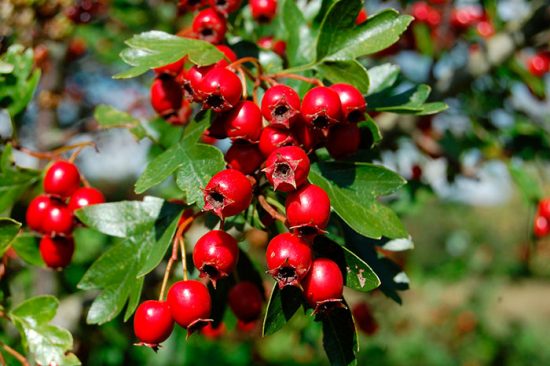

Everyone knows teas and decoctions made from hawthorn. But few know that hawthorn can also be harvested in winter (both the fruit and the flowers). The branches of the plant are laid out in a cool, well-ventilated area. The carefully dried flowers are neatly folded into fabric bags and stored in a dry room.
16 excellent varieties of plums for the Moscow region
It is also important to have an idea of who the hawthorn can do not benefit, but harm. You can not use the plant in any form (teas, infusions, etc.) for children who are not yet 12 years old, pregnant and lactating mothers, as well as persons with individual intolerance to the components contained in hawthorn fruits.
Read also: Dried kumquat: uses, benefits and harms
All other categories of people should also not abuse hawthorn for one simple reason: it can cause severe dizziness.
Layers
Propagation of hawthorn by layering is a good way, but it is not suitable for all plant species, but only for its bush forms.
The technology is very simple. In late spring, one-year (or two-year-old) shoots of shrubs, without separating from the mother plant, are laid horizontally in pre-dug trenches and attached to the ground with wooden spears or metal pins.
Then the trench is covered with earth, leaving the upper part of the shoot on the surface. It is very important to pull the shoot at the base so that the cuttings begin to take root on their own.We water the shoots abundantly and often and carry out 2-3 fertilizing with nitrogen fertilizer during the season. If necessary, add the required amount of earth so that the trunk of the cuttings is not exposed.
You can cover the ground around the top of the shoot with mulch - straw, hay, peat or pine needles are suitable for these purposes. Separation of the cut from the bush can be carried out in the fall, but if the rooting was not successful enough, it is preferable to postpone the crucial moment until next spring.
Did you know? Many legends and beliefs are associated with the hawthorn, moreover, in a directly opposite direction. This amazing plant was considered both the embodiment of evil, promising misfortune, illness and all sorts of troubles, up to the death of loved ones (especially if it is uprooted or broken), and a symbol of happiness in the family, virgin chastity, protection from evil spirits. For the Turks, the scent of hawthorn was associated with erotic thoughts and sexuality, and for the Scandinavians, on the contrary, with cold and death.
How to harvest
When it comes to the harvest, the fruits of the plant are usually mentioned. But from the hawthorn, you can collect not only fruits, but also flowers, leaves and even bark.
Flowers are collected when the tree is just starting to bloom. It should be borne in mind that the hawthorn fades quickly, in about a week. A pruner is used to collect flowers.
Leaves are harvested before and during flowering, are selected undamaged by diseases and pests, clean. They are cut off or cut off with scissors. It is worth making sure that 2/3 of the leaves remain on the branches.
Hawthorn fruits are harvested in early October, provided they are fully ripe. Berries are cut in bunches, rotting or damaged by pests are also collected, but thrown out.
On a note! The bark is cut in the spring during the sap flow season, because it is then that it is easiest to remove it from the trunk.
After harvesting, it is worth worrying about storing hawthorn gifts. Leaves, bark and flowers are scattered on a cloth or paper, placed in a room with good ventilation and stirred after a certain time. The fruits should be dried in ovens or special dryers with a temperature of 50 ° C. Everything is stored in paper, sealed in glass containers, distributed in fabric bags. The beneficial properties of leaves, fruits and bark lasts up to 2 years, in flowers up to 1 year.
Hawthorn fruits have a unique composition and include vitamin K, sugar acids, sorbitol, b-carotene, phenolic acid, coumarin and more. They help to improve the cardiovascular system, treat angina pectoris, arrhythmia, hypertension. Hawthorn is also prescribed for stress, insomnia, fatigue and even neurosis. It is recommended for diabetics, as it lowers blood sugar levels, and the astringent property helps with gastrointestinal diseases, is used as a diuretic.
Thus, hawthorn planting and maintenance is not demanding compared to many other garden trees, so breeding it is worthwhile. The tree will become an excellent decorative decoration for a summer cottage and will give a medicinal harvest for many years.
By planting a hawthorn in your courtyard, you will receive not only a decorative element in landscaping, but also a storehouse of medicinal raw materials. With high-quality seedlings and a well-chosen place for planting, caring for this plant will be reduced to an elementary minimum.
Where and how to plant a hawthorn, what you need to know to create a hedge, how to harvest useful inflorescences and fruits - we will talk about all this later in the article.
Root shoots (offspring)
This method is also mainly used for shrubby forms of hawthorn, since the root growth of trees is much less. The method is applied at the end of the season - in August or September. At first, the shoots that appear on the sides of the plant are very carefully separated from the mother bush. It is important not to damage the horizontal root, so as not to destroy the adult plant.After the offspring takes root (this can be verified next spring), it is carefully dug up and transplanted into a pre-prepared place.
An alternative breeding method for hawthorns is by root cuttings. In the fall, sections of the roots of the same length as green cuttings are carefully cut off from an adult plant. Then they are buried in the ground and left until spring.
When the frost has passed, each cutting is cut into two halves and buried in the ground at an acute angle with the thicker part down, so that the small tip remains on the surface. Rooting such cuttings requires compliance with the same conditions as green cuttings - a fogging device or a homemade greenhouse. If, after a few weeks, you notice young shoots appearing above the ground, the cuttings were successful.
The main breeding methods for hawthorn. Detailed description
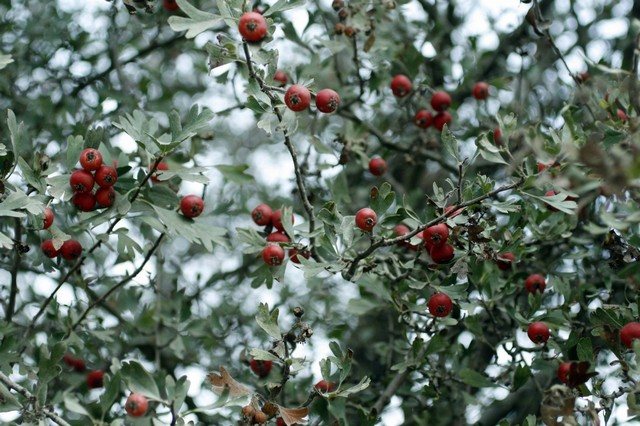

Hawthorn is a member of the Pink family. Among the large number of varieties and species of this plant, there are huge ten-meter trees and small shrubs. The external appeal allows the use of hawthorn in landscape design. Of particular value are fruits that are actively used for medical purposes. Representatives of agricultural enterprises and ordinary amateur gardeners are actively breeding hawthorns both for sale and for growing on their own land.
Growing from seeds
Seed propagation of hawthorn is almost as unreliable as propagation by cuttings. Among other things, it should be borne in mind that a plant that has grown from a seed does not necessarily inherit the characteristics of the parent, therefore, for especially valuable varieties of hawthorn, it is better to use vegetative propagation methods.
Did you know? In the wild, hawthorns are mainly propagated by seeds, not by ordinary spraying, but by a very peculiar procedure for the passage of the fruit through the digestive system of birds, pecking berries. Under the influence of gastric juices, the fruits break down and swell and, coming out naturally, give maximum germination.
The main problem of seed propagation of hawthorn is associated with the fact that it has very hard fruits that simply cannot germinate without additional processing. Alternatively, some advise using incompletely ripe berries for sowing, while their skin has not yet had time to harden properly.
Such fruits are laid out in small portions and left on their own for several months. Rotten berries are cleaned, placed in peat and left alone again until next spring, when shoots should appear.
In addition to this method, other tricks are used. For example, the shell can be artificially destroyed (so-called scarification). This can be done mechanically, chemically or thermally.
With regard to hawthorn, the second or third methods are most often used. With chemical scarification, the fruits are placed for several hours in a 3% solution of hydrochloric or sulfuric acid (or for a day in a 1% solution of sodium salt of nitric acid), after which they are well washed with cold water. Thermal scarification is an easier way. The berries are simply placed in a cotton bag and alternately dipped in boiling water and ice water for about 30 seconds. As a result, the fruits should swell and grow in size, after which they are ready to plant.
The same procedure can be carried out in a different form: the berries are planted in peat and watered with warm water. After a few months, they switch to contrast watering, using water at the temperature of ice melting.
As a preparation of seeds for planting, the usual stratification is also used (for 4 months the fruits are kept warm in peat, and then placed for the winter at a temperature of several degrees above zero).
Accelerated seed preparation involves soaking in warm water for several days (the temperature must remain warm, for this the container with the seeds can be put on a battery or placed near another heat source). However, seeds should always be soaked, including after scarification and stratification. Without preliminary preparation, hawthorn seeds will not sprout for several years. But even with proper processing, such fruits germinate very poorly, often get sick, are damaged by pests and various diseases.
Planting, given the poor germination, is carried out in the winter way (prepared seeds of the last year are used). At the same time, germination can occur not next spring, but only after a year and a half.
After planting, the land (it should be very fertile) is thoroughly watered and covered with peat, straw or pine needles and left to winter in this form.
Hawthorn seedlings are oval, fleshy cotyledonous leaves with a length of 0.5 to 1.5 cm. The stem under them has a characteristic reddish color. During the first 2 years of life, such sprouts increase in size by only 10 cm per year or even less, then the growth rate increases several times. This continues until the plant reaches 8 years old, after which the growth rate decreases again.
As you can see, it is quite difficult to grow hawthorn seeds with seeds, the only plus is that if everything works out, you can get a large number of new plants at a time, which is excluded with vegetative propagation methods.
In addition to the options described, it is worth mentioning another breeding opportunity for hawthorns, which has recently appeared due to the accelerated development of technology. It's about cloning.
In this way, a huge number of new plants are obtained very quickly. The bottom line is that a specially treated kidney is first placed in a nutrient medium, and then the resulting sprout is transplanted into a greenhouse. Unfortunately, today this option remains inaccessible at home: absolute sterility and a special laboratory are needed. So, we have considered all possible ways to breed a hawthorn in your own country house. Each of them has its own characteristics, advantages and disadvantages. The choice is yours!
Growing hawthorn: 300 years without much care
Hawthorn is very unpretentious, grows on poor soils and in places with poor ecology. Easily tolerates both excess and lack of moisture, light, does not freeze in severe winters.
During periods of prolonged drought, the leaves curl up and dry out, and after rain come to life again. I have a hawthorn growing in three different places on the plot. Near the column there is already a tree 5 meters high, by the road there are beautiful fluffy bushes, and near the fence, under the poplar, the hawthorn develops worse, blooms poorly, does not give fruit at all, it is much lower than its counterparts planted at the same time. Practice shows that in more favorable conditions the hawthorn develops better.
The hawthorn has a very powerful root system, and it lives for 300-400 years.
Once again I want to emphasize that it is very beautiful all year round. For the winter, bushes and small trees shed their leaves, and their branches look very beautiful - purple-brown, shiny, planted with thick, up to 10 cm, thorns. These spines are not fully formed shoots. Tiny leaves grow on them, but they soon die off. The thorns are as hard as nails. During the period when there are still no flowers, hawthorn is good with an interesting leaf shape. Then flowers appear - white, not double, not very chic, collected in umbrellas, somewhat similar to rowan flowers, only larger. The smell is not for everybody.
Reference by topic: Michurin varieties
The plant blooms very richly and steadily.
In autumn, the leaves are dark green, slightly pubescent on both sides, turn orange-red.In late September - early October, fruits ripen, large spherical berries the size of a sweet cherry, red, with mealy pulp and 3-4 seeds, hanging in tassels on long legs. These berries are very tasty!
Both a single plant and a group look good. The hawthorn can be trimmed to shape the bushes into different shapes, which means it can be used to create an unusual hedge. But I have apple and pear trees growing on my site, and they have common diseases with the hawthorn, so I cannot use it as a hedge.
This plant can also be planted with cuttings and layering. But, in my opinion, seeds are preferable: there is no need for material investments, it is possible to preserve the variety, it begins to bear fruit much earlier. Hawthorn begins to bear fruit in 10-15 years, but then it gives good and regular harvests without additional fertilizing and frequent watering. It's also extremely useful, but that's a topic for an entire article.
<надежда сотникова="" г.="" старый="">
Below are other entries on the topic "Cottage and garden - do it yourself"
- Hawthorn - planting and care (advice from a professional gardener): Hawthorn - cultivation and benefits Usually ...
- Growing hawthorn - planting and care, advice and feedback: How to grow hawthorn in the gardenClinical ...
- How to grow a seedling from a stone - exotic plants: Growing a seedling of exotic plants from ...
- Planting and caring for a medlar - tips: How to grow a medlar A medlar is quite ...
- A flower garden on poor, arid soil, what to plant (planting plan and plants): SMART, ECONOMY, BRIGHT: PLANTS ON ...
- Date palm from the stone: Is it possible from the stone of the date ...
- Ornamental fruits and berries - what plants they are on: Plants (shrubs, lianas, trees) with ...
Subscribe to updates in our groups.
Let's be friends!

